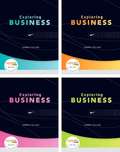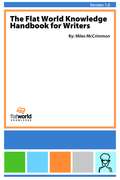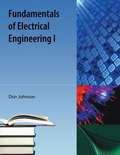- Table View
- List View
Essentials of Geographic Information Systems
by Jonathan Campbell Michael ShinEssentials of Geographic Information Systems integrates key concepts behind the technology with practical concerns and real-world applications. Recognizing that many potential GIS users are non-specialists or may only need a few maps, this book is designed to be accessible, pragmatic and concise. Essentials of Geographic Information Systems also illustrates how GIS is used to ask questions, inform choices and guide policy. From the melting of the polar ice caps to privacy issues associated with mapping, this book provides a gentle, yet substantive, introduction to the use and application of digital maps, mapping and GIS.
Essentials of Nutrition
by Maureen Zimmerman Beth SnowEssentials of Nutrition: A Functional Approach, by Zimmerman and Snow is a textbook aimed at non-majors for the nutrition course. With this text your students will examine some of the popular myths about nutrition and will develop a foundation for making smart dietary choices and to debunk these common nutrition myths. As students learn about the role of nutrition in optimal health, they will learn about dietary nutrients and toxicants. A sampling of topics covered include macro- and micronutrient needs; determining individual nutrient and caloric needs; digestion and absorption; nutritional needs throughout the various stages of human development; and current food issues, sustainability concerns, including food safety.
Exploring Business
by Karen CollinsCollins is the only Introduction to Business book to teach students the topics of business through an in-depth study of a single company--Nike. How do you show your students the relationships between what they are learning in the classroom and what happens in the real business world? What happens when your students don't see the connections between the theory they are learning in the classroom and what is happening in the real business world?
Exploring Perspectives: A Concise Guide to Analysis
by Randall FallowsThis 5 chapter primer will help give students a better understanding of how to discover, develop, and revise an analytical essay for their argument and persuasion courses.
FHSST: Grade 10 Maths
by Rory Adams Mark Horner Heather Williams Sarah BlythGrade 10 maths textbook for South Africa
FHSST: Grade 11 Physical Science
by Rory Adams Heather Williams Mark Horner Sarah BlythGrade 11 physical science textbook for South Africa
FHSST: Grade 12 Maths
by Rory Adams Mark Horner Heather Williams Sarah Blyth Wendy WilliamsGrade 12 maths textbook for South Africa
FHSST: Grade 11 Maths
by Rory Adams Sarah Blyth Heather WilliamsGrade 11 maths textbook for South Africa
FHSST: Grade 12 Physical Science
by Rory Adams Heather Williams Mark Horner Kosma Von MaltitzGrade 12 physical science textbook
FHSST: Grade 10 Physical Science
by Rory Adams Mark Horner Sarah Blyth Heather Williams Wendy WilliamsGrade 10 physical science textbook
Financial Accounting
by Joe Ben Hoyle C. J. SkenderThis book is suitable for an undergraduate or MBA level Financial Accounting course. If authorship matters (and we believe it is everything) then this book is destined to be a classic. There are no two better authors than these. Joe Ben Hoyle is co-author of two current market-leading advanced accounting textbooks with McGraw-Hill. He and and co-author CJ Skender are nationally recognized as master teachers. Both have won numerous teaching awards, and both were recently recognized by BusinessWeek as top undergraduate professors. The authors bring their collective teaching wisdom to bear in this book not by changing "the message"(financial accounting content), but by changing "the messenger" (the way the content is presented). The approach centers around utilizing the Socratic method, or simply put, asking and answering questions. The reason that this approach continues to be glorified after thousands of years is simple - it engages students and stresses understanding over memorization. So this text covers standard topics in a standard sequence, but does so through asking a carefully constructed series of questions along with their individual answers.
A First Course in Electrical and Computer Engineering
by Louis ScharfElectrical and computer engineering textbook
The Flat World Knowledge Handbook for Writers
by Miles MccrimmonAre you teaching freshman level students? Is this one of the first college level courses your students have ever taken? Probably. That is why this English Handbook is different (and we think better). Miles McCrimmon's, The Flat World Knowledge Handbook for Writers is based on the understanding that writing is at the center of the college experience, not just something students do on their way to "higher-level" coursework. The Flat World Knowledge Handbook for Writers supports the goal of acculturating entering students to the demands of college-level thinking and writing, whether that goal is being met through coursework in Composition, Student Development, or some combination of the two.
Focusing on Organizational Change
by William Q. Judge Jr.Never before have strategic leaders been confronted with so much overwhelming change. The traditional approach taken by the leader or leaders is to direct or control the organization's reaction on a monthly, weekly, or even daily basis. This approach is stressful and overwhelming for executive leaders, makes middle managers feel torn between honoring their senior leaders and listening to the demands of frontline employees, and is alienating for frontline employees. This approach is hardly a prescription for the pursuit of excellence, and does not enable the organization to be sufficiently agile or nimble to cope with the "white water" conditions in which the organization typically finds itself. This book offers an alternative to the traditional approach by focusing on building the change capacity of the entire organization in anticipation of future pressures to change. An organization's capacity for change is an eight-dimensional dynamic capability of an organization or organizational unit to successfully adapt to the changing organization-environment interface. In change-capable organizations, the strategic leader's role is more of an architect or designer of the organization in anticipation of oncoming change, rather than a commander or controller reacting to change. This approach unleashes the organization's creative potential while maintaining accountability, clarifies the roles of each and every employee in the change process while enhancing organizational flexibility, aligns organizational systems to facilitate change, and builds the organization's leadership pipeline for the future. Based on systematic research of more than 5,000 respondents working within more than 200 organization or organizational units conducted during the previous decade, this book offers a clear and proven method for diagnosing your organizational change capacity. Building on my previous consulting experience and anecdotal evidence, you will also learn how to enhance your organization's change capacity. While building organizational change capacity is not fast or easy, it is essential for effective leadership and organizational survival in the 21st century. This book provides guidance on how to do that essential work in the new millennium.
Foundations of Business Law and the Legal Environment
by Don Mayer Daniel M. Warner George J. Siedel Jethro K. LiebermanMayer, Warner, Siedel and Lieberman's Foundations of Business Law and the Legal Environment is an up-to-date textbook with comprehensive coverage of legal and regulatory issues for your introductory Legal Environment or Business Law course. The text is organized to permit instructors to tailor the materials to their particular approach. The authors take special care to engage students by relating law to everyday events with which they are already familiar with their clear, concise and readable style. Business Law and the Legal Environment provides students with context and essential concepts across a broad range of legal issues with which managers and business executives must grapple. The text provides the vocabulary and legal savvy necessary for business people to talk in an educated way to their customers, employees, suppliers, government officials -- and to their own lawyers. With Foundations of Business Law and the Legal Environment, the authors have created a text that not only has both case summaries and excerpted cases, but one that you can easily customize by deleting chapters, reordering the content, adding your own material, and even editing at the line level with Flat World's easy-to-use MIYO (Make It Your Own) Platform.
Fundamentals of Electrical Engineering I
by Don JohnsonThe course focuses on the creation, manipulation, transmission, and reception of information by electronic means. Elementary signal theory; time- and frequency-domain analysis; Sampling Theorem. Digital information theory; digital transmission of analog signals; error-correcting codes.



